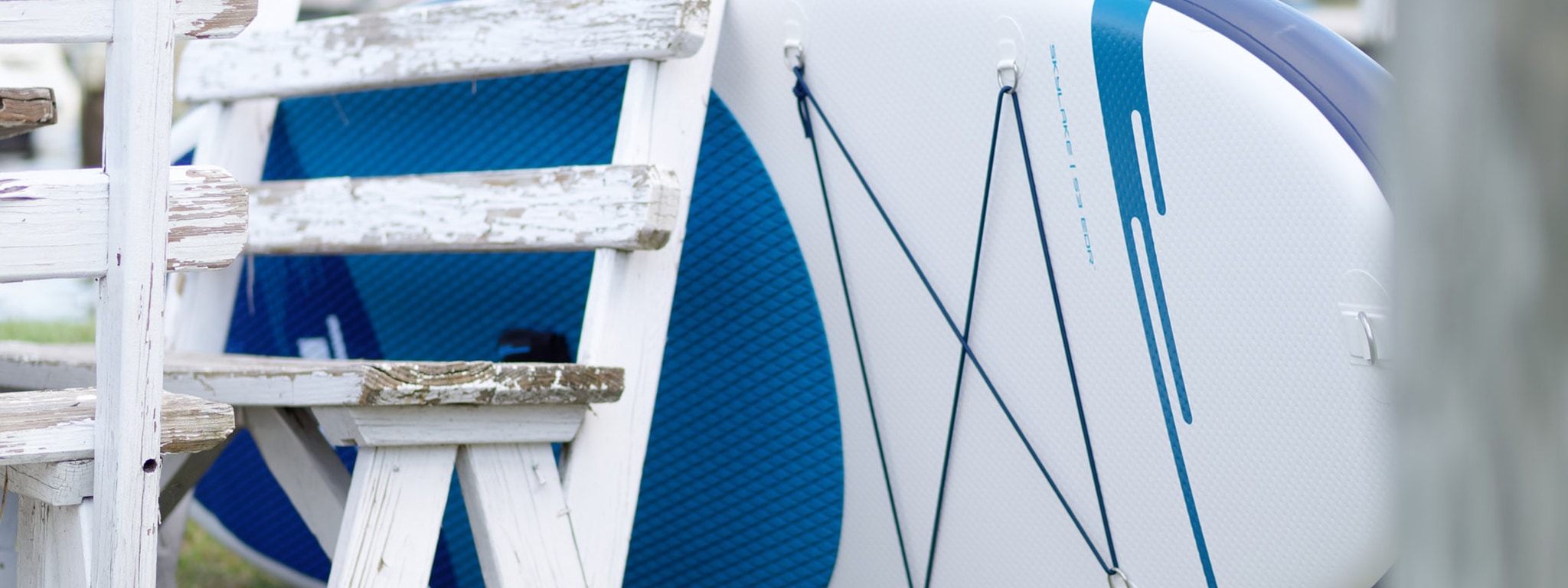
What To Look For In A Paddle Board Cargo Tie-Down System
Updated May 6, 2025
One of the most overlooked aspects of a stand up paddle board is its provisions for carrying things on board. Whenever you venture out on your SUP board, you’ll need a place for your water bottle at a minimum, but at some point, you’ll want to take more on board - sandals, a dry bag with phone, wallet, and keys, snacks, dry clothes, and anything else you’ll want for an outing on the water.
Given the importance of being able to take things with you on your board, you should really pay some attention to the bungee tie-down system on any board you are considering for purchase.

Front Bungee System
The front of the board is the most convenient location to secure your gear. The position slightly forward of the end of the deck pad is ideal because it is easy to reach from a kneeling position or sitting cross-legged, and is a location where you’ll generally never need to put your feet while paddling. The front bungee system usually comes in one of three basic configurations:
The X. The X is the classic bungee setup and the most practical. it consists of a crossover that creates an X with the elastic and works because it holds what is under it from different angles. This is the perfect configuration for 90% of paddlers who will use their bungees to basic items such as shoes, water bottle and a dry bag.
The Double X. The Double X adds another row of d-rings and creates a double crossover. This usually expands the carrying space toward the front of the board. This is a good system for overnight adventures or on touring boards where the board design is centered on carrying more gear. For all-around paddling, and even touring casually it is excessive, and you are most likely to use only the lower X because it is easier to reach without having to reach too far forward on the board.
Straight. Some boards come with a bungee system consisting of two or three cords that are parallel to each other, which give the board a different aesthetic, though using the straight bungees requires a slightly different approach to securing your cargo because the straight cords only exert hold in one direction.
Depending on how the system is implemented, it's not problematic for most all-around paddling use, provided attention is paid to items with a tendency to shift and the implementation of the system. You can also convert most straight bungee systems to an X or Double X by replacing the cord and rigging it in that formation.

Rear Bungee System
The rear of the board is another location where bungee tie-down points are sometimes provided for securing cargo. Having a set of tie-down cords at the back of the boards often looks good in concept, with a load at the front of the board and a load at the rear, though for an all-around board their limitations become apparent.
While it makes some sense to try balancing a heavy load between the front and rear of the boards, having bungees or gear in this location can seriously get in the way of your footwork or cause you to trip if you stumble backward if you are not using them to tie down gear.
It is more difficult to reach for items secured at the rear of the board, as it requires that you rotate your body around to access, which can be awkward and put you off balance on the water. Rear bungees with the bungee cord removed also pose an issue where the d-rings are left 'floating' and it can create snagging hazards.
Rear bungees have their place for paddlers whose primary use of their board requires carrying extra cargo. This is why you will often see them on larger touring, river expedition and fishing boards designed with this as a functional purpose. For all-around boards, they are not a good design choice, and for paddlers who will not be securing cargo on a regular basis, they may be considered a negative feature to factor into a buying decision.

Stainless Steel D-rings vs Fabric Tethers
Most D-ring systems will be made of a PVC loop and a stainless D-ring, though you will find fabric tether loops on a number of boards.
The use of stainless steel D-rings in SUP design are made for general durability and longevity. For most paddlers, D-rings will outlast the board and a D-ring system mainly needs to be simple and secure.

Fabric tethers are sometimes used for two possible reasons. The first is that they are softer, so if they are near the standing zone, paddlers are less likely to get hurt by stepping on them, compared to a metal ring. Second, they allow some flexibility in the angle used to secure cargo. Stainless steel D-rings are designed with about a 45-degree pivot, whereas a fabric tether can be pulled in more directions depending on what you are trying to tie down.
The first issue is better solved by not putting tie-down points near the standing zone. Having D-rings, hooks, or unnecessary handles anywhere near the center of the board is a poor design choice, though it is mitigated somewhat with the use of fabric tethers if they are secured since they will flatten if a paddler happens to stand on one.
Bungee systems should ideally be positioned with adequate clearance from the paddler if they fall, shift stances, or are required to take a knee. There is nothing worse than enjoying the wonderful feeling of paddle boarding, and worrying about standing, or tripping, on a poorly placed piece of plastic, d-ring or hook, that you don't really need on the board.
The potential downside to fabric tethers, like any fabric, is that they can wear out more quickly than steel if not cared for. This can be mitigate by general maintenance such as cleaning the board and rinsing components after use, especially if used in salt water environments.
If loose tethers are not tied down with a bungee cord, they still represent a hooking hazard which is why it is important to consider how many bungees and tie downs you will really use during your paddling.
These limitations are acceptable if the rest of the board is designed to be used for hauling cargo, and if you actually use the additional tie-down points on a regular basis for expeditions or fishing.

Conclusion
Regardless of where the tie-downs are located on the board, the basic things to look for in a bungee system are:
- Appropriate spacing of the D-rings to leave ample width to fit cargo under the tie-downs, without being excessive.
- Stainless metal D-rings or strong fabric tethers over plastic are preferred, because failure could cause you to lose your valuables. Fabric tethers are an acceptable compromise and design choice, provided you intend to make regular use of them and keep them tied down when not in use.
- Decently sized rings or loops, at least wide enough to slip a buckle through and hold a basic X-shaped bungee system.
- The arrangement of bungees should not compromise the performance of your board.
When evaluating the bungee system on a paddle board, the most important factor is to distinguish between tie down points that have been put there for practicality vs. unnecessary attachments that will clutter your board if you will not be using them.
Extra tie-down points that you won't use add weight and are obstacles that get in your way while paddling or relaxing on your board.
Generally speaking, a well-spaced set of four tie-down points just forward of the deck pad is the most practical setup, unless you have a specific need for more cargo space, such as for overnight camping trips where tents and sleeping bags might need to be carried on board.


Want Expert Advice on Choosing an Inflatable SUP Board?
Check out our 2025 Inflatable Paddle Board Buying Guide - or - The Best Inflatable Paddle Board - Reality vs the Internet.
Want To Buy an Inflatable SUP Board?
Explore our range of SUP boards for sale by activity / use in Inflatable SUP Type or focus on Inflatable SUP Brands to find the right board for you.
Want Answers to Anything Stand Up Paddle Boarding and Inflatable SUP?
The Pumped Up SUP SUP Paddle Blog is the best resource on the internet for up to date information to help with your next inflatable SUP purchase!




